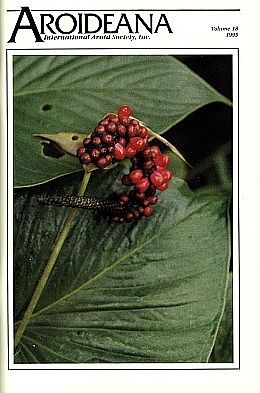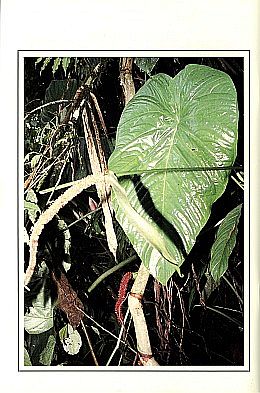|
|



Your search for articles published in volume 18 has found 13 articles.

| 
|
Articles of 3 pages or less are available for free to IAS members for download, and longer articles for $5. Articles from issues in 2016 and beyond are only available electronically, and are free to current members when they are logged in.
Please remember that all Aroideana articles are protected by copyright, and you may NOT distribute even electronic copies without permission from the authors or editor.
(Issue) |
||||
| Amy Donovan | From the editor
This article available FREE to IAS Members with a PERSONAL login. LOGIN, REGISTER or JOIN | |||
| ABSTRACT: This volume of Aroideana marks a very important event in my life, an event I thought would come to pass last year. We are finally and absolutely caught up! | ||||
| Shri Niwas Singh, Madhav Gadgil | Ecology of Amorphophallus species in Uttara Kannada District of the Karnataka State (Buy) | |||
| ABSTRACT: Several Amorphophallus species are cultivated for their edible tubers. Nine of their congenerics are present in the Western Ghats. The abundance, spatial distribution patterns, and ecology of these species were studied. Based on abundance the habitat preference for these species in decreasing order is as follows: open scrub, mesa, Acacia auriculiformis plantations, disturbed evergreen forests, cashew and eucalyptus plantations, casuarina plantations, and betelnut orchards. Within a particular habitat, the spatial distribution patterns were clumped. The reasons behind such clumping could lie in their dispersal, reproductive ecology, and species associations. The implications of such distribution patterns on in situ conservation measures for these plant species are discussed. AmorphophalIus species seem to be plants of humid habitats preferring an intermediate level of dis· turbance but not large scale habitat transformations. Large scale habitat transformations seem to be breaking their ecological links with their pollinators and dispersal agents resulting in reduction of their populations. | ||||
| Jim Donovan | Photograph: Alocasia macrorrhizos (L.) G. Don var. 'New Guinea Gold' growing at the editor's home.
This article available FREE to IAS Members with a PERSONAL login. LOGIN, REGISTER or JOIN | |||
| Scott Zona | Anthurium gymnopus in Cuba
This article available FREE to IAS Members with a PERSONAL login. LOGIN, REGISTER or JOIN | |||
| ABSTRACT: Just west of Havana, near the town of Candelaria, in the province of Pinar del Rio, one can find Anthurium gymnopusGriseb., a curious and seldom-seen species endemic to western Cuba. | ||||
| David J. Leedy | I hate the ates
This article available FREE to IAS Members with a PERSONAL login. LOGIN, REGISTER or JOIN | |||
| ABSTRACT: A Short Poem | ||||
| Rick Cirino | Aroids in Columbia (Buy) | |||
| ABSTRACT: I had always wanted to go on a trip to Colombia, but I couldn't make it happen until May of 1994. With logistical help from some friends, I had drawn up an itinerary for a two week trip. My plan called for a flight into Cali, a drive up to the Choco via Risaralda, then a return to Cali where I would go to the areas west of the city. | ||||
| Thomas B. Croat, Li Heng | VI International Aroid Conference in Kunming (Buy) | |||
| ABSTRACT: The VI International Aroid Conference was held at Kunming in Yunnan Province in southern China between June 26 and July 1, 1995. The conference was well attended with 80 Chinese participants and 30 participants from Hong Kong and 10 other countries. These were India, Singapore, Thailand,Japan, South Africa, Croatia, Switzerland, Germany, England, and the United States. | ||||
| Dorothy C. Bay | Thermogenesis in aroids (Buy) | |||
| ABSTRACT: Thermogenesis, as it occurs in the plant inflorescence has been observed and studied for over two centuries. At least seven thermogenic families of plants are known including Annonaceae, Araceae, Arecaceae, Aristolochiaceae, Cycadaceae, Cyclanthaceae, and Nymphaeaceae. The sequence of thermogenic events is very precise and highly synchronized in each species. The physiology is not well understood, but the recent identification of salicylic acid as the triggering hormone for thermogenesis has opened the door for further research, especially in the areas of plant signal transduction pathways and systemically acquired resistances. Thermogenesis has proven to be an advantageous process to plants for maximizing pollination and limiting hybridization. Beetle pollinators also benefit from the phenomenon. | ||||
| Jim Donovan | Photograph: Anthurium veitchiiMasters growing in Joseph Fondeur's Tropical Paradise Nursery in Davie
This article available FREE to IAS Members with a PERSONAL login. LOGIN, REGISTER or JOIN | |||
| K. S. Patil, G. B. Dixit | Cytological studies in Araceae Part 1 (Buy) | |||
| ABSTRACT: The largely tropical monocot family Araceae, comprising about 105 genera and 3,500 species in the world (Li Heng, 1993), is an apparently natural and easily recognizable group. In Western Ghats of Maharashtra (India), the taxa of AIaceae are thriving well in both plains and hilly regions. The plants belonging to AIaceae are taxonomically interesting, showing varied habitats. The aim of the present work is to obtain chromosome data of as many hitherto unstudied genera as possible. The cytological work of AIaceae is well known. The chromosome numbers have so far been determined for more than 700 species from intraspecific taxa (Petersen, 1989, 1993) belonging to 99 of the 105 genera presently recognized (Bogner & Nicolson, 1991; Hay, 1992; Li Heng & Hay, 1992) _ The present study reports the chromosome numbers of nine species for the first time. | ||||
| Anonymous | Dan Nicolson advises us of this news release
This article available FREE to IAS Members with a PERSONAL login. LOGIN, REGISTER or JOIN | |||
| ABSTRACT: Readers might be interested to know that George Bunting has a nice treatment of aroids in P. E. Berry, B. K. Holst, & K. Yatskievych (eds.), Flora of the Venezuelan Guayana, vol. 2. | ||||
| Thomas B. Croat, Jimena Rodriguez de Salvador | Contributions to the Araceae Flora in northwestern Pichincha Province (Buy Back Issue) | |||
| ABSTRACT: This is the first in a planned series of local florulas leading to the complete revision of the Araceae for Ecuador. The ENDESA reserve, operated by the Universidad Catolica is located in central Ecuador in an area of Premontane rain forest. The flora, now known to have 76 species of Araceae is still poorly known except for Anthurium, the subject of this revision. Thirty-two species of Anthurium are treated. Ten new species and one new variety are described. New taxa are Anthurium balslevii Croat &J. Rodriguez, A. cabuyalense Croat & J. Rodriguez, A. cupulispathum Croat & J. Rodriguez, A. hebetatilaminum Croat &J. Rodriguez, A. jaramilloi Croat & J. Rodriguez, A. jimenae Croat, A. magnifolium Croat & J. Rodriguez, A. nigropunctatum Croat & J. Rodriguez, A. pulverulentum Sodiro var. adsimile Croat & J. Rodriguez, A. rodrigueziae Croat, and A. silanchense Croat & J. Rodriguez. One new combination is made, Anthurium propinquum Sodiro var. albispadix Croat & J. Rodriguez. | ||||
| Anonymous | Index
This article available FREE to IAS Members with a PERSONAL login. LOGIN, REGISTER or JOIN | |||
All Images and Text © 1996 to 2024 by the International Aroid Society or by their respective owners as noted.
Please send your comments to
served by aws-web2
